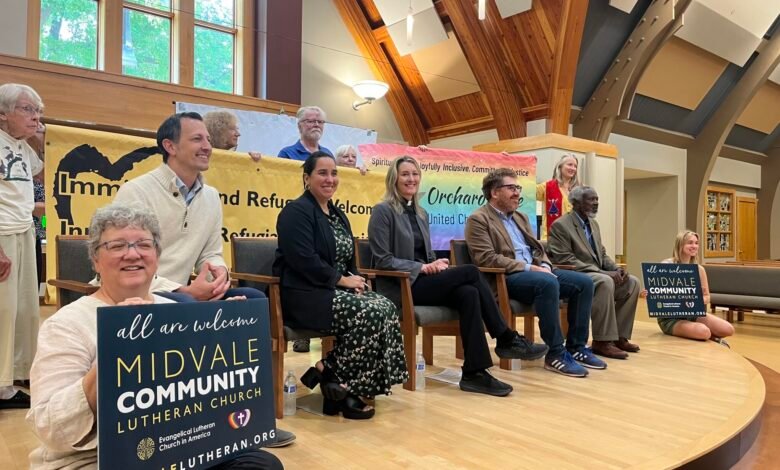Wisconsinites push back on anti-immigrant attacks • Wisconsin Examiner

Republican vice presidential candidate J.D. Vance traveled to western Wisconsin this week to double down on his spurious attacks on immigrants, promising to “kick these illegal aliens out.”
It was the second time in two weeks that Republicans have campaigned in the rural, western part of the state on their “mass deportation” platform.
The region where Vance and U.S. Rep. Derrick Van Orden made their recent stands against immigrants is heavily dependent on immigrant labor. Immigrants make up a large majority of the workforce on area dairy farms and they do most of the heavy lifting for other key businesses in the area including Ashley Furniture — the world’s largest furniture manufacturer — and the Pilgrim’s poultry processing plant.
Western Wisconsin has experienced a big recent demographic shift with an influx of Latin American immigrants. And those newcomers have revitalized small towns across the region that were in decline because young people are moving away, leaving an aging white population. Mexican restaurants, grocery stores and other small businesses have given new life to fading Main streets and young families have filled schools that were on the brink of closure from low enrollment.
It’s hard to keep up with all the falsehoods politicians are spreading about immigrants in this campaign season. Among the doozies Vance dropped during his visit to Eau Claire was his baseless assertion that immigrants caused two area hospitals to close recently and that mass deportation will “make the business of rural health care much more affordable.”
The closure of those rural hospitals was agonizing for the communities that struggled to hold on to them. An aging patient population, low Medicare and Medicaid reimbursements, trouble finding and keeping staff, and a larger harsh landscape for nonprofit hospitals were among the factors that caused the hospitals to close. But neither the legislators who worked on the issues nor hospital management pointed to immigrants as the problem. There’s good reason for that.
Across the country, immigrants use the U.S. medical system far less than people born in the U.S. A study published in the American Journal of Public Health found that: “Recent immigrants were responsible for only about 1% of public medical expenditures even though they constituted 5% of the population,” and “immigrants’ medical costs averaged about 14% to 20% less than those who were US born.”
As Alison Pfau, bilingual regional dairy educator for the University of Wisconsin Extension, has seen that phenomenon up close. She explained during a panel I participated in this week that given a choice between seeking medical care and staying on the job, “immigrant workers will choose to keep working every time, unless it’s a dire emergency.”
Meanwhile, national research shows that immigrants — including those without legal status — pay more into government health care programs through tax withholdings than they use in benefits. In 2022, undocumented immigrants paid almost $100 billion in taxes, about a third of which went to Medicare and Social Security — programs they will never be able to use —Wisconsin Watch reports. Without them, U.S. safety net programs would take a big hit.
Other misleading campaign talking points mix up immigrants who are in the U.S. without legal authorization, like most Wisconsin dairy workers, with refugees and asylum seekers like the atrociously slandered Haitian refugees Vance and Trump have been falsely accusing of eating pets in Springfield, Ohio — who are here under U.S. protection and therefore not, contrary to campaign rhetoric, eligible to be deported.
Antonio De Loera-Brust, a United Farm Workers spokesman, told Wisconsin Watch that the point of anti-immigrant rhetoric is not a real policy plan. After all, deporting millions of workers would be logistically impossible, in addition to depriving U.S. agriculture of a huge portion of its labor force. Employers who support Trump despite his threats, De Loera-Brust theorized, aren’t worried about losing their workers — they see the rhetoric as a way to frighten farmworkers so they don’t demand their rights. “I don’t think you need to psychoanalyze it that much further beyond, ‘This is in their economic interest,’” he told Wisconsin Watch.
He has a point. There is nothing coherent or logical about the barrage of hateful rhetoric about immigrants. Fear itself seems to be the point. And a system in which a disempowered workforce lives in fear is a system that is bound to be rife with exploitation.
Still, some farmers do object to the nasty characterization of immigrants. They point out that there is no legal visa for year-round farm work, even though the U.S. has depended on these workers to do jobs Americans don’t want to do for decades now. They want a visa program that recognizes that work and gives the people who’ve been here a long time a path to citizenship.
Perhaps the most important thing to understand about all the political flame-throwing over communities supposedly afflicted by immigrants is that many of the people who live in those communities don’t agree that they are afflicted at all.
I found this out when I interviewed local leaders in Whitewater, Wisconsin, which was the focus of a lot of misleading political spin about a supposed sudden “flood” of Nicaraguan asylum seekers causing a crime wave. It turned out that story was false.
Eau Claire, like Whitewater, has been welcoming asylum seekers from other countries for years, and, as in Whitewater, residents there say the experience has enriched their community.
Matt Kendziera, executive director of Wisconsin Faith Voices for Justice, lived in Eau Claire for 29 years before moving to Madison last year. He said he never heard divisive talk about the arrival of people from other countries in the community until Vance visited this week to talk about the scourge of immigration. “Eau Claire has been a wonderful and welcoming community to the refugees who are there,” he told me. Many former refugees have become community leaders, he added, running for city council and becoming active in the local schools.
I spoke to Kendziera Thursday during a news conference at the Midvale Lutheran Community Church in Madison, where faith leaders who are part of the Dane Sanctuary Coalition were speaking out against “the growing number of vicious, racist lies, hatred, bomb threats, persecution and death threats against asylum seekers,” according to a coalition press release.
“This church has had the privilege of accompanying asylum seekers,” said Midvale Lutheran’s co-pastor, Rev. Katie Baardseth. Families from Cameroon, Ukraine and Colombia fleeing persecution and violence had found “peace and success in Madison,” she said. The experience of welcoming those families had benefited the congregation, she added.
Rabbi Jon Prosnit of Temple Beth El talked about Jews’ historical experience: “We’ve been targeted, we’ve been scapegoated. … We are always on guard lest our own hearts harden,” he said, adding that welcoming and protecting outsiders is “the most repeated injunction in the entire Torah.”
Ibrahim Saeed, president of the Islamic Center of Madison, described the history of the Muslim people as a history of persecution and exile but also of being welcomed by strangers. God made humanity, he said, “so you can get to know each other, not to despise each other.”
Without a doubt, there’s a demographic shift going on in Wisconsin, especially in rural areas. But community leaders, employers and regular citizens in Wisconsin communities like Whitewater, Eau Claire and Arcadia have embraced the change and the energy and economic and cultural benefits that come with it.
It’s inspiring to talk to people who have opened their hearts, welcoming newcomers and feeling their own lives and communities enriched by the experience.
Contrary to all the toxic rhetoric, immigration is a net plus for our country, and especially for the white, rural areas the Trump/Vance campaign is targeting in Wisconsin. Beneath the noise of the political campaign, a lot of people in those communities can tell you about it.
GET THE MORNING HEADLINES DELIVERED TO YOUR INBOX
Source link



